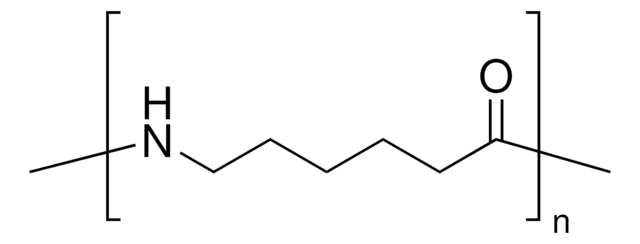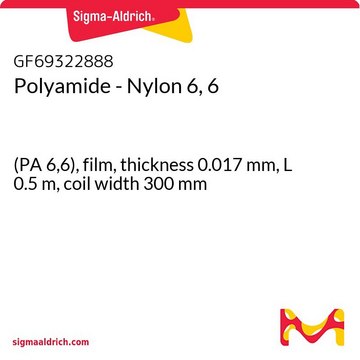All Photos(3)
About This Item
Linear Formula:
[-NH(CH2)5CO-]n
CAS Number:
MDL number:
UNSPSC Code:
12162002
PubChem Substance ID:
NACRES:
NA.23
Recommended Products
form
pellets
Quality Level
autoignition temp.
815 °F
transition temp
Tm 228.5 °C
Tg 62.5 °C
density
1.084 g/mL at 25 °C (lit.)
SMILES string
NC(=O)CCCCC
InChI
1S/C6H13NO/c1-2-3-4-5-6(7)8/h2-5H2,1H3,(H2,7,8)
InChI key
ALBYIUDWACNRRB-UHFFFAOYSA-N
Looking for similar products? Visit Product Comparison Guide
Related Categories
Application
Nylon 6 can be used as starting material to prepare:
- Silica nanoparticles–nylon 6 composites for extraction of hormones from aqueous samples.
- Polymeric nanofibers by electrospinning method. These nanofibers can be used to fabricate highly efficient nanofilters.
Storage Class Code
11 - Combustible Solids
WGK
WGK 3
Flash Point(F)
Not applicable
Flash Point(C)
Not applicable
Choose from one of the most recent versions:
Already Own This Product?
Find documentation for the products that you have recently purchased in the Document Library.
Customers Also Viewed
Anna Lindqvist et al.
Perception, 41(11), 1373-1391 (2012-01-01)
Twenty participants scaled similarities in odour quality, odour intensity and pleasantness/ unpleasantness of 10 binary and 5 higher-order mixtures of 5 odorous degradation products from the polymer Polyamide 6.6. The perceived odour qualities of all binary mixtures were represented well
Fei Hang et al.
Nanotechnology, 22(36), 365708-365708 (2011-08-17)
A nanomechanical testing set-up is developed by integrating an atomic force microscope (AFM) for force measurements with a scanning electron microscope (SEM) to provide imaging capabilities. Electrospun nanofibers of polyvinyl alcohol (PVA), nylon-6 and biological mineralized collagen fibrils (MCFs) from
Seiji Negoro et al.
The Journal of biological chemistry, 287(7), 5079-5090 (2011-12-22)
We performed x-ray crystallographic analyses of the 6-aminohexanoate oligomer hydrolase (NylC) from Agromyces sp. at 2.0 Å-resolution. This enzyme is a member of the N-terminal nucleophile hydrolase superfamily that is responsible for the degradation of the nylon-6 industry byproduct. We
Hem Raj Pant et al.
Journal of colloid and interface science, 364(1), 107-111 (2011-09-06)
In this work, different fractions of solvent-induced polymer degraded solution were mixed with freshly prepared solution of same polymer, and its effect on fiber morphology of electrospun mats was investigated. Nylon-6 solution in formic acid was allowed to degrade for
Habib Bagheri et al.
Analytica chimica acta, 716, 34-39 (2012-01-31)
A novel solid phase microextraction (SPME) fiber was fabricated by electrospinning method in which a polymeric solution was converted to nanofibers using high voltages. A thin stainless steel wire was coated by the network of polymeric nanofibers. The polymeric nanofiber
Global Trade Item Number
| SKU | GTIN |
|---|---|
| 181110-1KG | 4061826741009 |
| 181110-25G | 4061838755131 |
| 181110-500G | 4061838755148 |
Our team of scientists has experience in all areas of research including Life Science, Material Science, Chemical Synthesis, Chromatography, Analytical and many others.
Contact Technical Service








